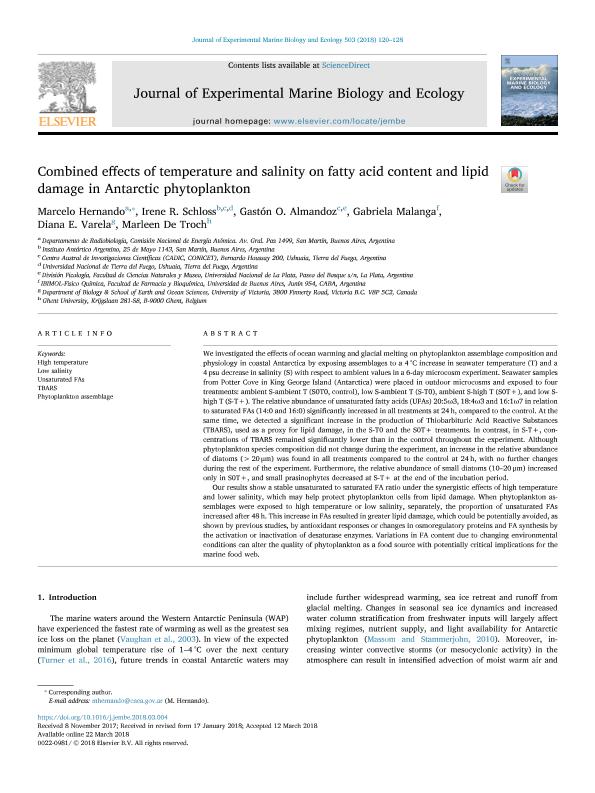Artículo
Combined effects of temperature and salinity on fatty acid content and lipid damage in Antarctic phytoplankton
Hernando, Marcelo Pablo ; Schloss, Irene Ruth
; Schloss, Irene Ruth ; Almandoz, Gaston Osvaldo
; Almandoz, Gaston Osvaldo ; Malanga, Gabriela Fabiana
; Malanga, Gabriela Fabiana ; Varela, Diana E.; De Troch, Marleen
; Varela, Diana E.; De Troch, Marleen
 ; Schloss, Irene Ruth
; Schloss, Irene Ruth ; Almandoz, Gaston Osvaldo
; Almandoz, Gaston Osvaldo ; Malanga, Gabriela Fabiana
; Malanga, Gabriela Fabiana ; Varela, Diana E.; De Troch, Marleen
; Varela, Diana E.; De Troch, Marleen
Fecha de publicación:
06/2018
Editorial:
Elsevier Science
Revista:
Journal of Experimental Marine Biology and Ecology
ISSN:
0022-0981
Idioma:
Inglés
Tipo de recurso:
Artículo publicado
Clasificación temática:
Resumen
We investigated the effects of ocean warming and glacial melting on phytoplankton assemblage composition and physiology in coastal Antarctica by exposing assemblages to a 4 °C increase in seawater temperature (T) and a 4 psu decrease in salinity (S) with respect to ambient values in a 6-day microcosm experiment. Seawater samples from Potter Cove in King George Island (Antarctica) were placed in outdoor microcosms and exposed to four treatments: ambient S-ambient T (S0T0, control), low S-ambient T (S-T0), ambient S-high T (S0T+), and low S-high T (S-T+). The relative abundance of unsaturated fatty acids (UFAs) 20:5ω3, 18:4ω3 and 16:1ω7 in relation to saturated FAs (14:0 and 16:0) significantly increased in all treatments at 24 h, compared to the control. At the same time, we detected a significant increase in the production of Thiobarbituric Acid Reactive Substances (TBARS), used as a proxy for lipid damage, in the S-T0 and the S0T+ treatments. In contrast, in S-T+, concentrations of TBARS remained significantly lower than in the control throughout the experiment. Although phytoplankton species composition did not change during the experiment, an increase in the relative abundance of diatoms (>20 μm) was found in all treatments compared to the control at 24 h, with no further changes during the rest of the experiment. Furthermore, the relative abundance of small diatoms (10–20 μm) increased only in S0T+, and small prasinophytes decreased at S-T+ at the end of the incubation period. Our results show a stable unsaturated to saturated FA ratio under the synergistic effects of high temperature and lower salinity, which may help protect phytoplankton cells from lipid damage. When phytoplankton assemblages were exposed to high temperature or low salinity, separately, the proportion of unsaturated FAs increased after 48 h. This increase in FAs resulted in greater lipid damage, which could be potentially avoided, as shown by previous studies, by antioxidant responses or changes in osmoregulatory proteins and FA synthesis by the activation or inactivation of desaturase enzymes. Variations in FA content due to changing environmental conditions can alter the quality of phytoplankton as a food source with potentially critical implications for the marine food web.
Palabras clave:
HIGH TEMPERATURE
,
LOW SALINITY
,
PHYTOPLANKTON ASSEMBLAGE
,
TBARS
,
UNSATURATED FAS
Archivos asociados
Licencia
Identificadores
Colecciones
Articulos(IBIMOL)
Articulos de INSTITUTO DE BIOQUIMICA Y MEDICINA MOLECULAR
Articulos de INSTITUTO DE BIOQUIMICA Y MEDICINA MOLECULAR
Citación
Hernando, Marcelo Pablo; Schloss, Irene Ruth; Almandoz, Gaston Osvaldo; Malanga, Gabriela Fabiana; Varela, Diana E.; et al.; Combined effects of temperature and salinity on fatty acid content and lipid damage in Antarctic phytoplankton; Elsevier Science; Journal of Experimental Marine Biology and Ecology; 503; 6-2018; 120-128
Compartir
Altmétricas



